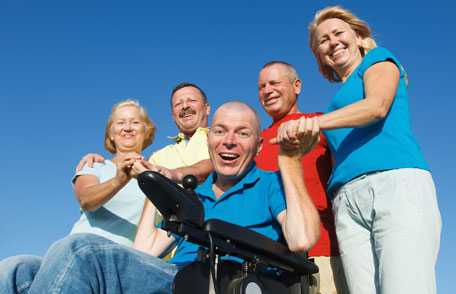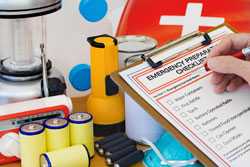Emergency Readiness for People with Disabilities
 For the 57 million Americans with disabilities, medical emergencies and natural disasters present real challenges. Learn how people with disabilities, their families, and first responders can plan ahead for a disaster.
For the 57 million Americans with disabilities, medical emergencies and natural disasters present real challenges. Learn how people with disabilities, their families, and first responders can plan ahead for a disaster.
571 million Americans have a disability, and anyone can be at risk for developing or acquiring one in their lifetime through illness, injury, or aging. People with disabilities may face barriers to everyday activities, such as reading small print, understanding instructions, getting to places or hearing what is said. This is particularly relevant when disasters strike and people are forced to leave or be confined in their home.
During disasters and emergency situations people with disabilities may need additional assistance to obtain the services they need. Universal design, accessible environments, and easy-to-read information, are only some examples of the strategies that can be implemented to make sure that everyone is safe during an emergency.
People with disabilities and their family members should make plans to protect themselves in the event of an emergency. It is also important that first responders know how to evacuate people with disabilities quickly and safely.
People with Disabilities – You Can Be Prepared
Planning ahead is required to protect yourself and your family when emergencies occur. You are in the ideal position to plan for your own safety as you best know your abilities and needs during and after an emergency or disaster. You can prepare for emergencies by planning ahead with your family and/or care attendants. CDC, along with its partners, has available resources that can help you be prepared. For example

People with disabilities - You can prepare for emergencies by planning ahead with your family and/or care attendants.
"Ready Now!" Toolkit
The "Ready Now!" Toolkit [2.91 MB] from the Oregon Office on Disability and Health is for people with disabilities and emphasizes independence, allowing each person to address his or her specific needs. Topics include
- Identifying emergency situations;
- How an emergency may change his or her abilities and independence;
- The importance of developing a personal contact list;
- Assembling a 72-hour supply kit of food, water, special medications, and personal supplies;
- Preparing pets and service animals for emergencies;
- Developing evacuation plans; and
- The importance of regularly updating emergency preparedness plans.
Get Ready! Toolkit
The Get Ready! Toolkit [2.62 MB] from the Alaska Health and Disability program will help you prepare for an emergency. Making an emergency plan and putting together your emergency kit is a big job. Your plan may include family, friends, neighbors, and organizations that support you and can help you make decisions. Your toolkit does not have to be perfect, but it is important to plan ahead.
Alaska also developed the Get Ready! Toolkit webinar to assistAlaskans and others with disabilities and their caregivers in putting the Get Ready!Toolkit into action.
Smart911
Smart911 is a free service used by public safety agencies across the country to enhance communication and response for their community. It can be used by
- 9-1-1 agencies to quickly send first responders to the location of an emergency with more information;
- Emergency management to better plan for and respond to disasters; and
- Municipalities to send emergency notifications to their citizens.
Smart911 allows you to create a private safety profile that instantly transmits information you specify to the 9-1-1 dispatcher's computer screen when you place an emergency call. This technology allows dispatchers to relay critical care information to emergency responders in the field even if you are unable to communicate.
Learn more about Smart911.
Several state-based disability and health programs around the country are now encouraging people with disabilities to sign-up for Smart911 or similar programs. For example,
- Montana
The Montana Disability and Health program has created an Emergency Medical Information (EMI) kit to promote awareness of Smart911 and to offer support for people with disabilities who may need help creating their profiles, as well as provide information about available emergency preparedness materials. - Rhode Island
The Rhode Island Special Needs Emergency Registry (RISNER) is designed to identify individuals who may require special assistance during emergencies, such as people with disabilities, long-term conditions, like diabetes, heart disease, and epilepsy, and other special healthcare needs.
The information submitted to the Rhode Island Special Needs Emergency Registry is shared with local and state first responders and emergency management officials. The Department of Health and Rhode Island Emergency Management Agency have worked with E-911 to notify first responders when they are responding to a household that may have someone enrolled in the Registry. This notification allows first responders to consider how best to respond to that incident.
Keeping Children Safe
Children with disabilities are particularly vulnerable during emergency situations and caregivers need to be proactive and plan for the safety of the whole family. CDC offers resources that can help protect your child from an emergency and to reunite with your child quickly and safely.
Protecting your child is as easy as A-B-C:
- Ask how you would be reunited with your child in an emergency or evacuation
- Bring extra medication, special foods, or supplies your child would need if you were separated overnight
- Complete a backpack contact information card [487 KB] and tuck one in your child's backpack and your wallet
Emergency Managers and First Responders – How to Assist People with Disabilities
During an emergency, people with disabilities may require additional assistance from emergency managers or responders. Some physical disabilities may be obvious while others, such as mental illness or intellectual disabilities, may not. Respecting all people with disabilities and treating them with dignity must be part of the response.
Disability Trainings for First Responders and Emergency Planners
The Ohio Disability and Health Program has developed two training videos on Disability and Emergency Preparedness, one targeting Emergency Planners and the other targeting First Responders. Each video provides information and best practices that seek to help you ensure the safety of people with disabilities and yourself during emergency events. You can find the training videos at
- Disability Training for Emergency Planners: Serving People with Disabilities
- Disability Training for First Responders: Serving People with Disabilities.
The Ohio Trauma Committee Functional Needs Work group has also developed a video to teach you how to handle service animals in emergency situations.
This is a simple, easy-to-use tip sheet with information for assisting people with a wide range of disabilities. Originally developed by the University of New Mexico's Center for Development and Disability, this tip sheet is now being distributed around the country by Disability and Health programs in several states.
References
- U.S. Census Bureau; American Community Survey, 2011 American Community Survey 1-Year Estimates, Table S1810; generated by Michael H. Fox, using American FactFinder; (16 July 2013).
More Information
More Information
- To find more information about emergency preparedness, visit Emergency Preparedness and You.
- To find more information about the health of people with disabilities, visit Disability and Health.
- To find more information about disabilities, visit National Center on Birth Defects and Developmental Disabilities.
- Page last reviewed: September 28, 2015
- Page last updated: September 28, 2015
- Content source:
Error processing SSI file


 ShareCompartir
ShareCompartir